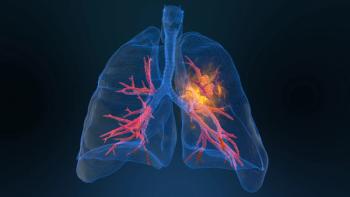
Small cell lung cancer is initially responsive to platinum-based chemotherapy, but it does develop drug resistance over time, furthering the need for better treatment options.

Small cell lung cancer is initially responsive to platinum-based chemotherapy, but it does develop drug resistance over time, furthering the need for better treatment options.

A clinical pharmacy specialist examines treatment strategies for EGFR exon 20 insertion mutations, referencing data from the PAPILLON trial, and addresses the challenges associated with managing brain metastases in this patient population.

Cara Chang, PharmD, BCOP, provides a comprehensive analysis of the MARIPOSA-2 trial, evaluating the various study arms and interpreting the practice-changing data presented.

A biologics license application (BLA) for patritumab deruxtecan receives complete response letter due to inspection findings at third-party manufacturer.

The PALOMA-3 trial showed subcutaneous amivantamab was better than IV among lung cancer patients.

Jordyn P. Higgins, PharmD, BCOP, discusses the evolving treatment landscape for small cell lung cancer (SCLC).

A renowned lung cancer pharmacy specialist presents the efficacy and safety data from the phase 3 FLAURA2 trial, emphasizing progression-free survival and overall survival outcomes, and shares additional insights from the MIRAPOSA study.

Cara Chang, PharmD, BCOP, examines the prevalence of EGFR positivity, provides an overview of clinically relevant EGFR mutations, and discusses therapeutic options for EGFR-positive mutations.

Repotrectinib has also shown significant efficacy in ROS1 fusion-positive non¬–small cell lung cancer (NSCLC), which was also studied in the TRIDENT-1 trial.

Osimertinib demonstrates improved progression-free survival for stage 3 epidermal growth factor receptor-mutated (EGFRm) lung cancer.

Nicolas Girard, MD, PhD, discusses the results of the PALOMA-2 trial, highlighting the subcutaneous (SC) delivery of amivantamab combined with lazertinib as a first-line treatment for advanced non-small cell lung cancer (NSCLC) with EGFR mutations.

The PALOMA-3 trial showed subcutaneous amivantamab was better than IV for lung cancer patients.

The phase 3 LAURA trial data presented at ASCO 2024 showed osimertinib (Tagrisso; AstraZeneca) reduced risk of disease progression or death in patients with stage 3 EGFR-mutated (EGFRm) non–small cell lung cancer (NSCLC) by 84%.

Results from the trial provide evidence bolstering ASCO’s clinical practice guideline supporting the integration of early palliative care into standard oncology practice.

Matthew A. Gubens, MD, MS, FASCO, highlights the importance of identifying genetic targets in metastatic non–small cell lung cancer (NSCLC), emphasizing the latest updates and strategies.

Individuals from a lower socioeconomic group showed more benefits from low-dose CT screening relating to lung cancer survival.

Tarlatamab is a first-in-class immunotherapy that binds to DLL3 tumor cells and CD3 T-cells, to kill DLL3-expressing SCLC.

SNB-101 is the first nanoparticle anticancer drug that was developed exceedingly insoluble SN-38 into polymer nanoparticles.

Pharmacists can raise awareness for lung cancer during and after Lung Cancer Action Week.

The new administration method, which is co-formulated with rHuPH20, is usable in previous approved nivolumab indications for solid tumors in adult patients.

A 76% lower risk was displayed with adjuvant alectinib compared to chemotherapy treatment for non–small cell lung cancer.

With this approval, alectinib is the first anaplastic lymphoma kinase inhibitor to be approved for patients with ALK-positive, early-stage non-small cell lung cancer.

Individuals treated with chemotherapy following a breast cancer diagnosis were more at risk of developing second primary lung cancer.

Both dual primary endpoints—progression-free survival and overall survival—were met with durvalumab.

Whitney Lewis, PharmD, BCOP, discusses how the treatment armamentarium for NSCLC has expanded in recent years and the associated cause for this acceleration.